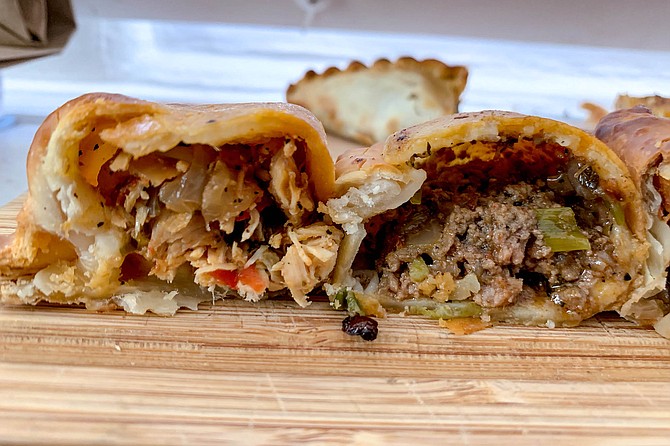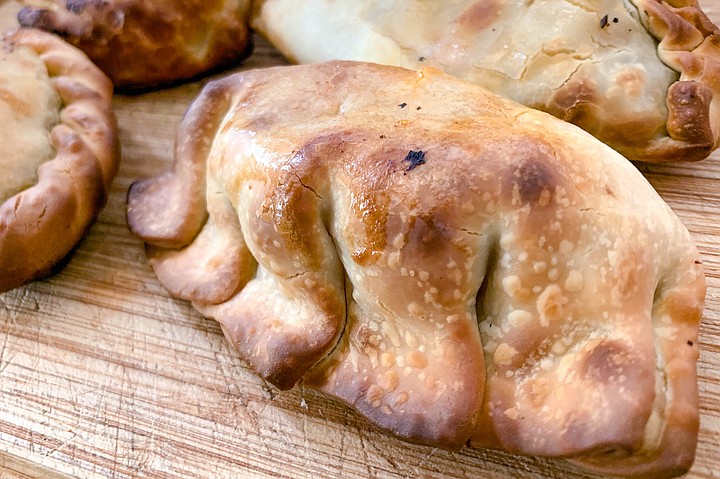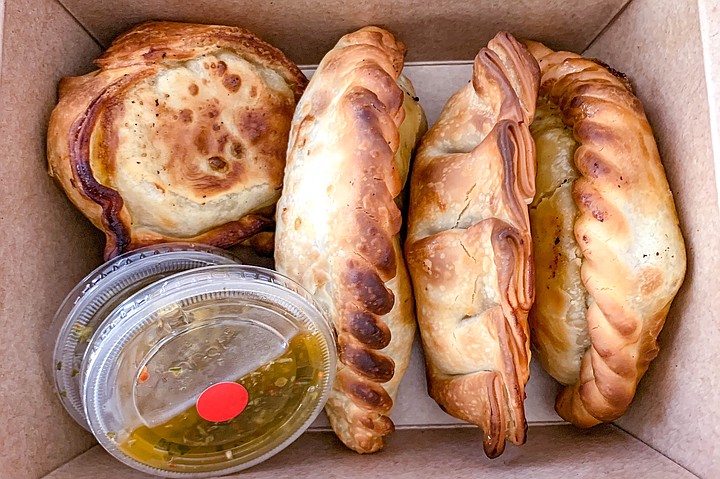 Facebook
Facebook
 X
X
 Instagram
Instagram
 TikTok
TikTok
 Youtube
Youtube

Pierogi, sambusa, calzone, pupusa: the world has come up with a lot of cool sounding words to describe what the English would call a pasty, and what we here in America might rather mundanely call a “hand pie.” I’d argue the best known variation of savory stuffed pastry is the most fun to pronounce: empanada. Made famous in Argentina (by way of Spain), the meat and/or vegetable filled morsels are easy to find in specialty shops around Buenos Aires. And the same could be said about San Diego these days, thanks in part to Empanada Kitchen.
It's one of those farmers market success stories. After a couple years as a vendor at the North Park weekly market, Empanada Kitchen upgraded to a brick and mortar shop downtown in early 2018. This fall, the business grew again, expanding into a second storefront location; this one back in North Park.

The new spot is found on El Cajon, The Boulevard, a couple short blocks west of 30th Street, in the same small strip mall home as the Heart & Trotter butcher shop. The casual counter eatery bears a similar, bright yellow design motif, and offers the same menu of empanadas found at the original location.

Which is to say, baked empanadas. Traditionally, they may be fried as well, but sticking to the oven here results in empanadas that more closely resemble single-serve pies, from the texture of the crust to the moist interior. If you really know a lot about empanadas, you might be able to tell which filling a specific one contains just by looking at it; subtle differences in how the empanadas are folded offer clues. For example, the beef empanada has sort of a half moon shape, with a braid running along its curved edge, while the chicken empanada replaces braids with a series of sequential folds. Conversely, the ham and cheese empanada is round, with a ridge circling its top edge.

Most of them cost $3.50 apiece, though you can make a meal of three for $9.50. The ground beef and shredded chicken in the aforementioned empanadas are stewed with minced vegetables, and are scrumptious. I must assume the same about the $4.50 lamb option that always seems to be sold out before I arrive. However, this is one of the rare street food shops that pays more than lip service to vegetarians. Meatless options include a caprese empanada (with basil, tomato, and mozzarella); mushroom and goat cheese; sweet corn and basil; and the vegan ratatouille empanada, which is stuffed with finely diced and roasted onions, peppers, garlic, zucchini, and eggplant. Naturally, all of the above go well with the house chimichurri (though I’m partial to the mild heat of a spicy version).

If you ask me, the coolest thing about a dedicated empanada restaurant is that you can shop your appetite. One makes for a quick, grab and go snack. Two fills you up about the same as a small sandwich. Mix and match three or more empanadas and you start to enter balanced meal territory, without any need for a fork.


Pierogi, sambusa, calzone, pupusa: the world has come up with a lot of cool sounding words to describe what the English would call a pasty, and what we here in America might rather mundanely call a “hand pie.” I’d argue the best known variation of savory stuffed pastry is the most fun to pronounce: empanada. Made famous in Argentina (by way of Spain), the meat and/or vegetable filled morsels are easy to find in specialty shops around Buenos Aires. And the same could be said about San Diego these days, thanks in part to Empanada Kitchen.
It's one of those farmers market success stories. After a couple years as a vendor at the North Park weekly market, Empanada Kitchen upgraded to a brick and mortar shop downtown in early 2018. This fall, the business grew again, expanding into a second storefront location; this one back in North Park.

The new spot is found on El Cajon, The Boulevard, a couple short blocks west of 30th Street, in the same small strip mall home as the Heart & Trotter butcher shop. The casual counter eatery bears a similar, bright yellow design motif, and offers the same menu of empanadas found at the original location.

Which is to say, baked empanadas. Traditionally, they may be fried as well, but sticking to the oven here results in empanadas that more closely resemble single-serve pies, from the texture of the crust to the moist interior. If you really know a lot about empanadas, you might be able to tell which filling a specific one contains just by looking at it; subtle differences in how the empanadas are folded offer clues. For example, the beef empanada has sort of a half moon shape, with a braid running along its curved edge, while the chicken empanada replaces braids with a series of sequential folds. Conversely, the ham and cheese empanada is round, with a ridge circling its top edge.

Most of them cost $3.50 apiece, though you can make a meal of three for $9.50. The ground beef and shredded chicken in the aforementioned empanadas are stewed with minced vegetables, and are scrumptious. I must assume the same about the $4.50 lamb option that always seems to be sold out before I arrive. However, this is one of the rare street food shops that pays more than lip service to vegetarians. Meatless options include a caprese empanada (with basil, tomato, and mozzarella); mushroom and goat cheese; sweet corn and basil; and the vegan ratatouille empanada, which is stuffed with finely diced and roasted onions, peppers, garlic, zucchini, and eggplant. Naturally, all of the above go well with the house chimichurri (though I’m partial to the mild heat of a spicy version).

If you ask me, the coolest thing about a dedicated empanada restaurant is that you can shop your appetite. One makes for a quick, grab and go snack. Two fills you up about the same as a small sandwich. Mix and match three or more empanadas and you start to enter balanced meal territory, without any need for a fork.
Comments